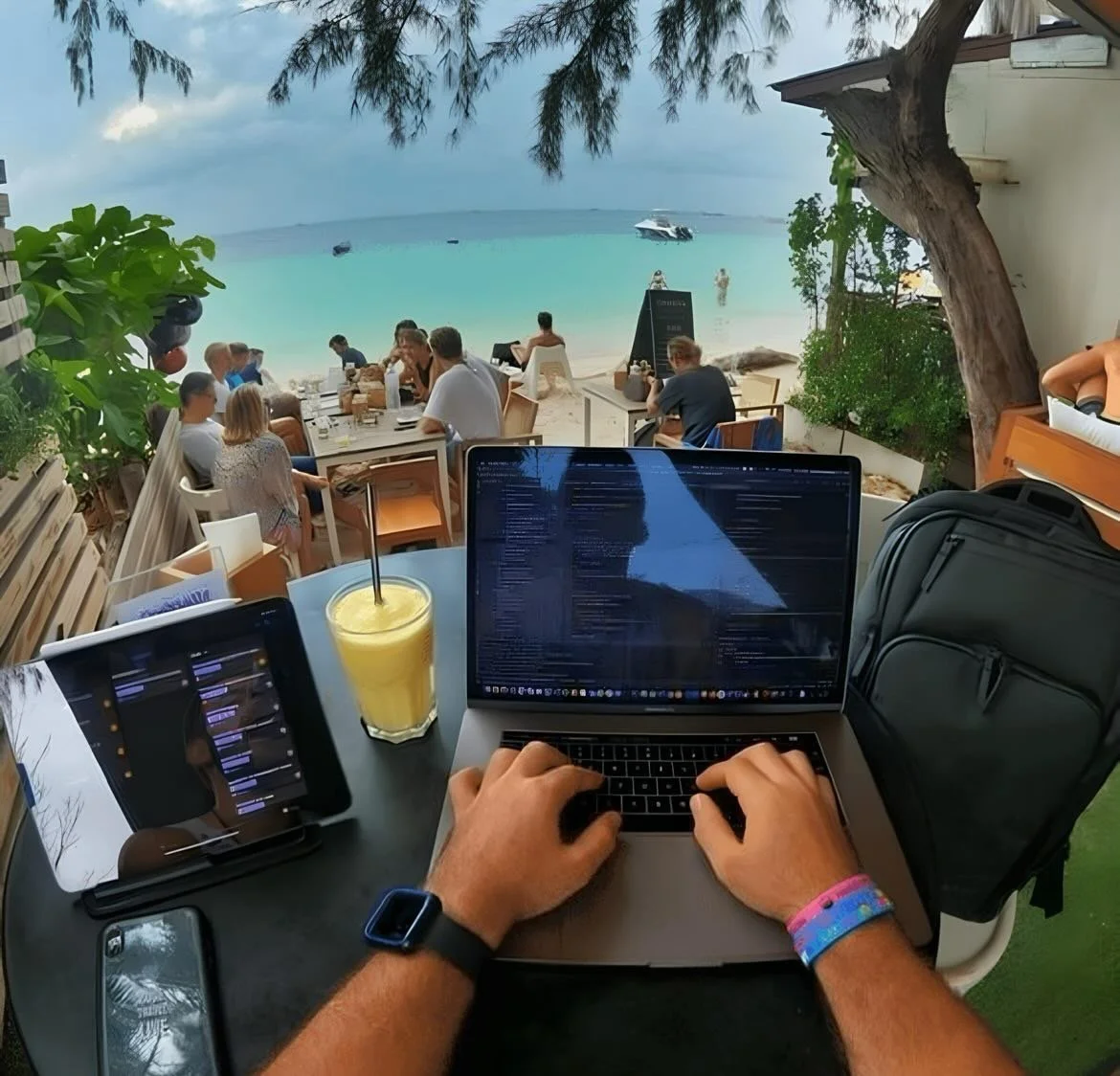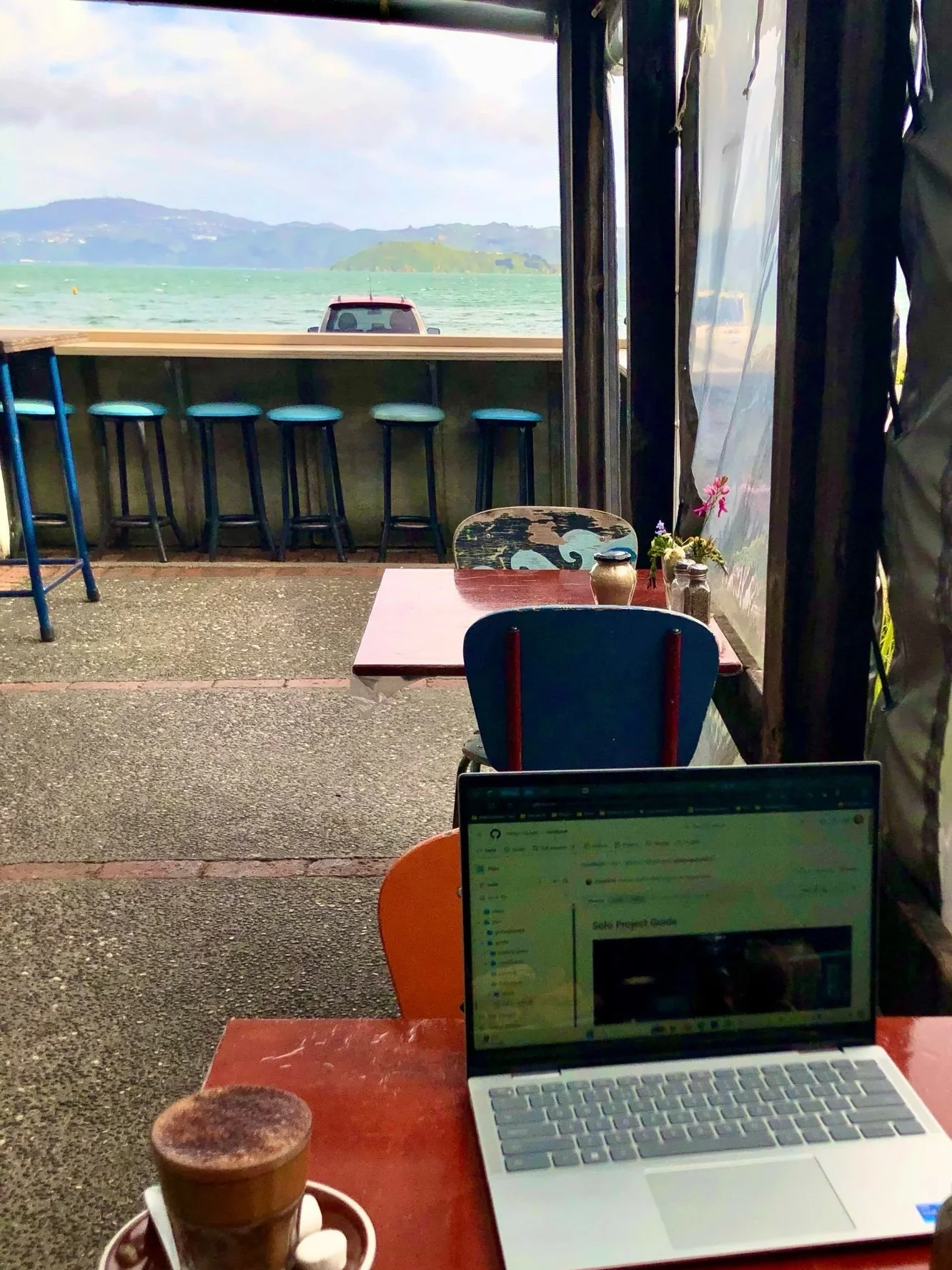From Personal Trainer to Traveling Physical Therapist Jobs: My Journey to Remote Freedom
Remote Jobs > Working Overseas > Personal Trainer Jobs to Traveling Physical Therapist Jobs
Introducing Eat Wander Explore
Here at Eat Wander Explore we believe that travel isn’t just about vacations – it’s a lifestyle. Our platform guides people through the three pillars of a location‑independent life: advice on travel, practical steps for transitioning into remote or traveling jobs, and support for moving overseas. We’ve helped countless readers learn how to work and live from anywhere through our Remote Coding Bootcamp and our FastLane Abroad relocation program. Whether you’re dreaming of exploring new cities while you work or yearning for a permanent move overseas, our resources are built to get you there.
We’re excited to share the following guest post by Shana Carter, who went from personal trainer to Doctor of Physical Therapy (DPT) and ultimately carved out a career landing traveling physical therapist jobs. Her story illustrates how flexible and well‑paid these roles can be – especially when you understand the market, salaries and companies involved.
My Journey from Personal Trainer to Doctor of Physical Therapy
by Shana Carter
I began my career as a personal trainer at seventeen years old and added the strength and conditioning coach title in my early twenties. I opened a small personal‑training company that serviced four locally owned gyms in my area. At 24 years old, I decided I wanted more free time, growth opportunities and less stress than owning my own business allowed. So, I sold my company and accepted a position as a personal trainer with a large corporate gym company. I spent almost four years with this large gym company and found myself working considerably more hours, dealing with considerably more stressors and declining physical and mental health; a change had to be made. While I thoroughly enjoyed my early career, minus the stress and never‑ending work hours, I wanted the opportunity to make better pay and a more significant impact on the community I served. I decided to pursue my Doctorate in Physical Therapy (DPT), which was quite a lofty goal as I did not even have a bachelor’s degree when I made this decision!
Early in my educational pursuits, I completed as many courses as possible at local and online colleges to decrease costs and increase the speed at which I could complete my undergraduate degree. I finished my first 18 months in this manner before transitioning to an undergraduate program at the University of Alabama at Tuscaloosa. I completed my bachelor’s degree in under three years and applied to begin my doctorate in physical therapy school. I was accepted to the University of St. Augustine’s accelerated doctoral program to complete my DPT degree during my first application cycle. What followed was a grueling and highly stressful 30‑month period, followed by my completion of the program and graduation in 2017.
Transitioning into Traveling Physical Therapist Jobs
Following graduation, I worked as a staff physical therapist for an outpatient clinic and a hospital for eight months before determining that I wanted more adventure and better pay in my career. I transitioned to traveling physical therapist jobs and began accepting contracts in skilled nursing facilities, assisted living facilities, hospitals and outpatient clinics in the state of Florida for 13 weeks at a time—and I fell in love! Seven years later, I continue to practice as a full‑time traveling therapist and am now licensed in five additional states.
Traveling physical therapy is lucrative compared with staff jobs. A 2023 article in the industry journal WebPT notes that traveling PT positions can pay 15–20 percent more than permanent jobs and lists an average travel physical therapist salary of roughly US $104,000 per year. A 2025 staffing report further estimates that travel PTs typically earn between US $95,500 and $115,000 annually, with weekly rates ranging from $1,800 to $3,000. The higher earnings stem from tax‑free housing stipends, per diems and bonuses. For those considering the assistant route, data from Vivian Health show that the average travel physical therapy assistant salary is about $1,508 per week (roughly $78,000 per year), which is significantly higher than the median annual wage for staff physical therapist assistants of $65,510. Even the traveling physical therapist assistant salary range of $15–30 per hour reported by CompHealth comes with housing stipends and per diems.
Top Traveling Physical Therapist Companies
Travelers typically partner with agencies that arrange contracts, benefits and licensing. According to The Non‑Clinical PT, some of the top traveling physical therapist companies include MedTravelers (AMN Healthcare), Fusion Medical Staffing, EPIC Special Education Staffing, Ardor Health Solutions and MedPro Healthcare Staffing. These agencies offer nationwide assignments, comprehensive insurance, housing assistance, free continuing education and 401(k) matching. Another useful resource, CompHealth, explains that agencies often pay for licensing, housing and malpractice insurance and provide benefits such as medical, dental and vision coverage.
Building a Remote Career Alongside Travel
However, after three years as a traveling physical therapist, I knew I wanted to add something education‑based to my career path, as I have always had a passion for instructing. I wanted the flexibility of working remotely to continue pursuing my passion for travel and working with rural healthcare communities. I decided to pursue developing and selling continuing‑education courses for clinicians and providers. I initially contacted Allied Health, a physical therapist‑owned education company based out of Raleigh, NC, to see if they would be interested in offering the orthopedic courses I wanted to write, and they agreed! Following two years with Allied Health, I wanted to further diversify my educational offerings, so I reached out to Summit Education to see if they would be interested in offering a new line of ergonomics courses I wanted to develop, and they were! Currently, I offer ten remote continuing‑education courses through Allied Health and Summit Education and plan to continue expanding my remote teaching practice until I can work fully remotely.
The pivot toward remote work isn’t unique to healthcare. A 2025 labor market survey by Robert Half reports that four in ten jobs in the United States now allow some amount of remote work, with nearly 26% of job seekers preferring fully remote roles. Flexible arrangements boost retention and broaden the talent pool. If you’re interested in joining the digital‑nomad movement but don’t have a healthcare background, consider Eat Wander Explore’s Remote Coding Bootcamp, which trains beginners to become software developers capable of working from anywhere.
Overcoming Challenges on the Road to Traveling Physical Therapy
So, while the journey I have detailed above appears to be all rainbows and butterflies, I can assure you it was not! There were numerous bumps and detours in the road, and I was often unsure whether I would ultimately achieve my long‑term goals of becoming a traveling physical therapist and remote continuing education instructor. During my second trimester in PT school, I failed my orthopedics course by a very small margin and had to fall back into the cohort behind mine to retake the course the next trimester. In PT school, you are at risk of being dismissed from the program if you fail a course more than once, so the stress level during my second attempt to pass orthopedics was very high! I had a wonderful mentor, Dr. David Kemfert, who met with me weekly to review the orthopedic concepts and ensure I understood the material, which resulted in me passing orthopedics the second time with flying colors!
For most of PT school, I was a single mother of a 15‑year‑old son. Juggling my son’s school obligations, attending his sporting events for track and lacrosse, and meeting all of my school deadlines and obligations while also trying to spend quality time with him was exceptionally challenging. The solution I came up with was time management and prioritization. I started getting up 45 minutes earlier than normal and completing my school reading for the next day so that I did not have to complete it at the end of the day after classes. I also set every Friday evening as family time with my son, so we had time to go to dinner, catch up on each other’s week, and go to the arcade or watch a movie afterward. I spoke with my son’s high school and requested that conferences and meetings be completed on Zoom since I was also in school full‑time and working. Lastly, I scheduled all of my Rover clients immediately before I went to class or directly following the end of my day so that I only had to leave my house again the following morning. With some schedule modifications, I successfully balanced my and my son’s school and work demands.
Developing Grit and Other Essential Skills for Traveling Physical Therapist Assistant Jobs
The journey from no degree to three degrees and multiple career changes over fourteen years requires many tangible and non‑tangible skills. Based on my own experiences, one of the most important and impactful skills I have found is the ability to develop “grit.” Grit is commonly defined as the ability to persevere in the face of adversity and continue moving forward despite repeated setbacks. Throughout my educational and clinical journey, I have experienced numerous setbacks that seemed world‑ending when they occurred. Still, I pushed forward, one step at a time, until the setback passed—a skill set known as grit. Several research studies have been completed that demonstrate students with high levels of grit are frequently more successful in attaining personal and professional goals than their counterparts with lower levels of grit. The great news is that grit is a skill set that can be developed!
A second skill set that is vitally important is time management and organization. When completing my DPT and Doctor of Education (EdD) degrees, I was raising my son and working while juggling a full‑time doctoral course load. At this time in my journey, I kept one planner for my son and his school activities, one for myself and my school activities and deadlines, and one for my work on Rover, where I worked as a dog walker and dog sitter during my degree completion. On any given week in completion of my degrees, we would be responsible for reading several hundred pages of material while being able to complete testing indicating we were proficient in the content covered. This amount of coursework and the demands of being a parent and working made time management imperative to complete my degrees successfully. However, keeping my deadlines for all activities organized and stored in a centralized location and ensuring I made time for myself and my son improved my stress levels. This approach also decreased the amount of unproductive time in my already hectic schedule.
I thoroughly enjoy working remotely and traveling as a physical therapist and plan to transition to living abroad and working entirely remotely within the next five years. Since transitioning to working as a traveling therapist and teaching online, I have noticed a drastic improvement in my work‑life balance. I no longer bring documentation home after work and spend hours completing chart reviews for patients at home before seeing them in the outpatient clinic. I also have increased the amount of time off I have each year to travel for vacation! I only work nine months out of the year and spend the other three months traveling outside the country!
Advice for Pursuing Traveling Physical Therapist or Assistant Jobs
If you want to follow this path and transition to traveling and working remotely, my most significant advice would be to research the path you want to pursue to determine the steps you need to take to achieve your goal. For example, for me to be able to pursue teaching continuing education courses remotely, I needed a certain number of hours as a clinician and some experience instructing in an educational setting. To make myself more marketable, I accepted a position teaching at a two‑year physical therapist assistant program for 12 months, which paid considerably less than I usually make. However, it expanded my experience and opened new doors in my career. I also volunteered to write articles and speak at local colleges to improve my CV and experience.
Another approach that I found invaluable is networking in the industry you are looking to begin working in. I joined educators’ special interest groups here in Florida. I also volunteered as a clinical instructor for DPT students and a mentor for new graduate physical therapists to improve my experience working directly with the student body I was interested in teaching. To attain approval to develop my first continuing‑education course, I leveraged my experience as a personal trainer and strength and conditioning coach. Most continuing‑education companies for clinicians want you to have at least seven to ten years of clinical experience to teach. I had less than five years of experience when I began to apply to develop my courses. However, I had a vast knowledge and background in functional movement screens and improving strength and posture. So, the first few courses I wrote and sold focused heavily on those topics. When attempting to transition from one career field or area to another, the best idea is always to leverage your current skills while you build the new skills you seek to market yourself for.
Lastly, you, too, can make the transition to working remotely and traveling if that is your career or lifestyle goal! Set your goal, develop your plan, determine how long you need to attain your goal and get started! Always remember that no matter how long‑term your ultimate end‑state goal is, break the overall goal down into manageable steps and only focus on one step at a time so you do not become overwhelmed. My overall goal of becoming a traveling physical therapist and remote continuing education instructor was a twelve‑year goal, which seemed utterly unrealistic and daunting when I looked at the big picture. So, instead, I focused on completing one course at a time, one semester at a time, until I reached the end. There will always be bumps and hurdles along the way, but half the fun is the journey necessary to achieve the life you have dreamed of and planned for!
Course: The Lowdown on Lumbago with a Touch of Pain Science by Shana Carter, PT, DPT, OCS, UDN-C, EDD
Start Your Own Remote Journey with Eat Wander Explore
Shana’s story proves that it’s possible to evolve from working mainly at local PT jobs into traveling physical therapist jobs, add remote teaching on top, and still maintain a family and personal life. With the right planning, grit and time‑management skills, you can start by transition into traveling physical therapist assistant jobs or other remote‑friendly careers. The pay is substantial - travel therapists often earn 15-20 percent more than non-traveling PT’s, averaging more than $2,200 per week, while travel PT assistants get paid about $1,500 per week while enjoying housing and per‑diem stipends.
Ready to start your own adventure? If you’re a healthcare professional, explore assignments through reputable travel therapy companies like MedPro Healthcare Staffing, Fusion Medical Staffing, MedTravelers, or learn more info about this process at Health Carousel. If you’re not in healthcare but want location independence, join our Remote Coding Bootcamp to build the skills for a remote tech job (these skills are in demand almost everywhere and have about 4x the number of remote work jobs than any other industry) or explore our Remote Jobs Starter Guide to learn about other types of remote careers and/or overseas jobs available to everyone. Eat Wander Explore is here to support you every step of the way—helping you eat, wander and explore your way to a life without borders.
Thank you VERY much for reading our article. We actually created this website to help people reach financial independence. Did you know that by having a remote job and traveling endlessly, or living in a country that has low costs of living, you can actually reach retirement quicker? Plus, retirement abroad is up to 75 percent cheaper as well! Learn more by exploring our website.
See our Thank You page to sign up for our free weekly newsletter - you’ll receive only 1 email per week letting you know about our latest travel articles, remote-work life, and amazingly affordable destinations!
Found this post useful? Buy us a coffee to help support this site’s running costs OR share this article with a friend.

































![Tech Elevator Demystified: Reviews, Legitimacy, and Winning Alternatives [2024]](https://images.squarespace-cdn.com/content/v1/5a028c7bbce1766d207a8a6f/1707008329038-96GH4TTYZATP6N3WDWXR/tech_elevator.png)
![Cracking the Code: Coding Dojo Reviews, Legitimacy Check, and Top Alternatives [2024]](https://images.squarespace-cdn.com/content/v1/5a028c7bbce1766d207a8a6f/1707007756149-VSJNN2PHHX2RWK6RSVQM/coding_dojo.png)


![App Academy Unveiled: Reviews, Legitimacy Check, and Top Alternatives [2024]](https://images.squarespace-cdn.com/content/v1/5a028c7bbce1766d207a8a6f/1707008090320-IUIIV4T416FP5ILRGK5W/app_academy.png)
![CareerFoundry Decoded: Reviews, Legitimacy, and the Best Alternatives [2024]](https://images.squarespace-cdn.com/content/v1/5a028c7bbce1766d207a8a6f/1707008030234-CZTE1805JUCU2M2GK7RO/careerfoundry.png)




